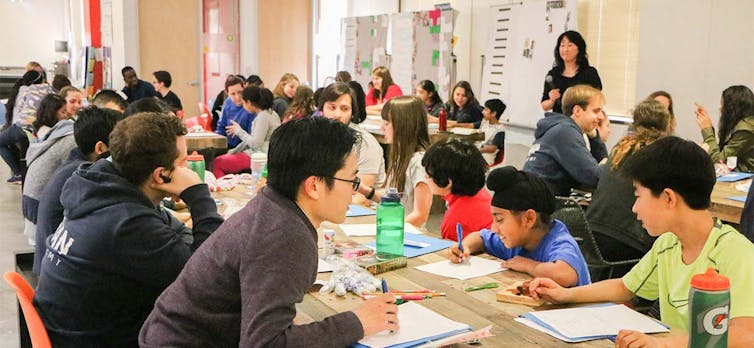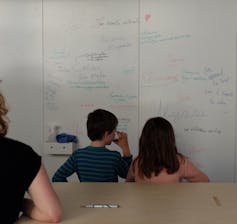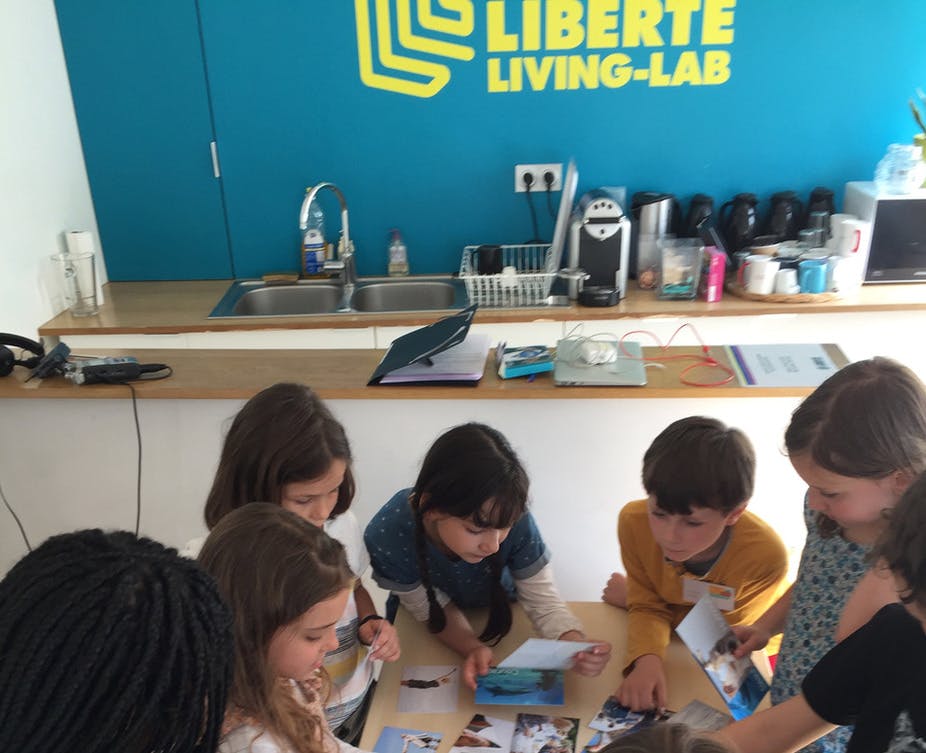What is a “laboratory school”? Simply put, it’s a school backed by a university department or an institution that trains teachers. Three complementary activities are associated with it: education, training and research (Wilcox-Herzog & McLaren, 2012). As a result of this structure, an organic link is naturally formed between education and research, which makes it possible to “develop and test new approaches, modeling best practices” (Cucchiara, 2010).
The development of lab schools
Lab schools have existed on university campuses for a long time: according to Cassidy & Sanders (2010), their existence would be documented as early as the 17th century, in Europe as well as Japan, where they are known as “attached schools” (Hayo, 1993). Lab schools grew considerably in the United States between the mid-19th and 20th centuries and have played a major role in the field of educational research. One of the most famous was founded in 1894 in Chicago by the psychologist and philosopher John Dewey (1859-1952) in the course of progressive education. Some of the best known lab schools today include UCLA, Washington, New York, and Toronto.
The multiplication of lab schools during the first half of the 20th century made it possible to carry out many educational experiments in a framework where they could be evaluated rigorously as they were implemented. In particular, they have contributed to our knowledge on child development. For example, they were the setting for the theory of mind was developed by John Flavell (Wilcox-Herzog & McLaren, 2012) and the famous marshmallow test developed by Walter Mischel that uncovered the link between the ability to postpone gratification and the chances of success in life.
A place to carry out educational experiments
Depending on the context, a varying level of emphasis can be placed on training and research. In Chicago, for example, research was clearly in a privileged position, while training of educational professionals was in the background. Conversely, some schools focused not on research but on applying Dewey’s theories, such as the Greenwood Laboratory School at the University of Missouri (Cucchiara, 2010). Others based their pedagogy on recent research in education, such as the Khan Lab School. The latter is not even affiliated with a university, but justifies the choice of the term lab school on its site:
“As a lab school, we monitor existing and new findings in education research and learning science to inform our programmatic choices.”
In any case, by integrating a school on campus, the university assumes a responsibility that is traditionally outside its field, as pointed out by Maia Cucchiara (2010). The creation of most of these schools is inseparable from a more general evolution of higher education, which is reflected in the United States through increased civic and community involvement by major research universities. Lab schools are mostly private because universities set up their own charter schools, but there is no reason why one of those school should not be a public institution and it may be a simple question of political will.
There is at least one in the United States: in 1998, the Pennsylvania Gazette announced that the University of Pennsylvania had partnered with a public school and the Philadelphia Teachers’ Federation to open a three-year public lab school. The school receives substantial support from the university ($700,000 annually, or $1,000 per pupil), supports the recruitment of additional teachers to reduce the number of pupils per class and thus improves considerably the rate of supervision compared to what it was before (the problem of overloaded classes is not, as we know, specific to France).

An international network
In an increasingly international environment, lab schools all over the world have begun to establish links with each other. Many are now affiliated with the International Association of Laboratory and University Affiliated Schools (IALS). As the IALS website indicates, the definition of a lab school is intentionally broad so as to accommodate a wide variety of configurations. Indeed, these differ considerably according to the contexts in which the schools are created: a lab school may be an institution formally integrated into a university department, such as the one founded by J. Dewey. This is the case for the majority of North American and Japanese lab schools, such as the Shinwa Kindergarten School of Kobe Shinwa Women’s University, recently affiliated with the IALS.
It can also be a system set up by a school that combines the skills of researchers to propose an “evidence-based” pedagogy. This is the case of the Labyrinth School in Brno, Czech Republic, that opened in September 2016. It is based on respect for the individual needs of children and aims at enabling each child to develop up to his or her maximum potential. It works in association with a think tank made up of school leaders, teachers, academics, non-governmental organizations and representatives of the Ministry of Education. It defines itself as a “modern, open, welcoming, bilingual, creative, active, community, for all, for the future”. Labyrinth School was the first lab school to join IALS in Europe.
Knowledge sharing and dissemination of practices
Beyond the heterogeneity of the structures, a lab school is characterized by participation in the construction of knowledge and by the application of a scientific or “evidence-based” approach to education. As researcher Franck Ramus points out, the word evidence refers to factual data rather than to actual evidence. The idea is to promote educational practices based on such data, as opposed to practices based on simple representations or philosophies. But in fact, this last approach is still undeveloped in France, where education and research always appear as an “improbable couple”.
Today, however, more and more voices are rising in our country in favor of increasing links between research and education, such as those of the researcher François Taddei, the former Minister of Education Najat Vallaud Belkacem as well as the current one, Jean-Michel Blanquer. Various recent initiatives are likely to reinforce them: this is particularly the case of the Associated Education Sites (LeA) set up within the framework of the French Institute of Education (IFÉ), the first Carnot Institute of Education (CIE) and projects such as La Main à la Pâte, Les Savanturiers or Syn Lab. However, the number of teachers and, consequently, of students who benefit from this evolution is limited. To enable scaling up, there is a need to improve initial and in-service training for teachers, as unanimously advocated by studies and reports informed by research published since the beginning of 2016, “Inequalities in schooling” report of CNESCO, the TIMSS study or the PISA survey.
Is it possible to adapt the concept of lab school in France?

In the French context, it is obviously necessary to reflect on the adaptation of such a system so as to reconcile it with the existing structures: we do not have a university research laboratory associated with a school or a school whose pedagogy is entirely based on the results of educational research.
A lab school is not only defined by a constant dialogue between research and pedagogical applications, some of them include in their mission to welcome cultural, social and economic diversity or the care of children with special needs (learning disabilities, ADHD, autism-spectrum disorders) involving families. They are therefore not institutions reserved for socially privileged persons, but places of social mixing, sharing, exchange and dissemination. The project of a lab school is to facilitate as much as possible the circulation of knowledge and practices by a policy of open education, putting the artefacts used by the teachers and the pupils in free access.
By necessity, lab schools will necessarily be noncontractual private institutions (a contract of association with the government can only be requested after five years of practice). Our hope is to create a dynamic that will, as soon as possible, establish public-private partnerships for the creation of other institutions and, if possible, the creation of public lab schools.


